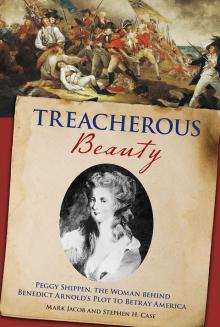- Home
- Stephen Case
Treacherous Beauty Page 6
Treacherous Beauty Read online
Page 6
While the guests were given plenty of notice, tickets printed with the official invitation were delivered only a day before the May 18 event. They read: “The favor of your meeting the subscribers to the Meschianza at Knight’s Wharf near Poole’s Bridge tomorrow at half past three is desired.”141
André had chosen Peggy Chew as the lady who would accompany him. His shield featured the image of two gamecocks fighting and his motto was “No rival.” Peggy Shippen was to be paired with a Lieutenant Winyard; his shield was decorated with a bay leaf and his motto was “Unchangeable.”142 But at the last minute, everything may have changed for Peggy Shippen. Simply put, Peggy either attended the Meschianza or she didn’t. On this, the evidence is hazy at best.
André wrote two accounts of the festivities, one in late May to be published in a London periodical, Gentleman’s Magazine, and the other in June as a private keepsake for Peggy Chew. In the first account, the Shippen sisters indeed attended the splendid party. In the second account, the sisters were off the roster, with no explanation for their absence.
According to a story told by later generations of the Shippen family, a group of disapproving Quakers paid a visit to Peggy’s father on Fourth Street just before the Meschianza. They thought it would be scandalous if Edward Shippen’s girls participated in such a spectacle. The Quakers reportedly didn’t complain about the girls’ dalliances with the British invaders, or the ladies’ ravenous consumption during a time of great privation. Instead they picked the argument that would work: that the girls’ “Turkish” costumes were indecent.
According to this story, related by descendant Lewis Burd Walker more than a century after the events, the father who had been so indulgent with his daughters finally put his foot down. And although Peggy and her sisters were “in a dancing fury” over their father’s edict, “they were obliged to stay away.”143
The Shippen family lore reveals that Peggy was prone to hysterical fits, and it has prompted speculation that her reaction to her father’s decision must have been an outburst on a grand scale. In Walker’s family history, he described Peggy’s tendency toward hysteria in the nicest possible terms, saying she sometimes experienced “nervous attacks of a hysterical nature when under mental excitement” and had “a susceptibility to fainting spells, to which she was subject whenever perturbation of mind reacted upon a delicately organized body.”144
Despite certain family accounts, some scholars believe the Shippen girls did indeed attend the Meschianza, and this view is supported by another Shippen descendant who wrote in the late nineteenth century, “I am in a position to sweep away all doubt on the subject, since Sarah Shippen was my grandmother, and was never tired of telling me all the delight and glory of that memorable fete. . . . They were there.”145
Neither version can be proven. But the case against the Shippens’ attendance seems stronger. Some believe André wrote his first account of the festivities ahead of time—before the Shippens pulled out—and then wrote the second version based on what actually occurred, sans Shippens. More likely than not, Peggy Shippen missed the Meschianza, the grandest party that she would ever have the opportunity to attend.
And what a time it was. First came a flotilla along the Delaware River. Three brightly decorated galleys carried the most honored guests. These were accompanied by twenty-seven barges holding the rest of the four hundred guests along with three bands of musicians. “The gaudy fleet, freighted with all that was distinguished by rank, beauty, and gallantry, was conveyed down the river, along the whole length of the city,” André wrote, “whilst every ship at the wharfs or in the stream was decked in all her maritime ornaments and covered with spectators.” Crowds lined the shore, “full of curiosity and admiration.” As the floating parade passed Captain Hamond’s Roebuck, his ship provided a nineteen-gun salute.
The party arrived at the Wharton house, and the musical bands combined to lead a procession that “advanced through an avenue formed by two files of grenadiers” to the field where a knightly tournament commenced. There the guests were divided into two groups of spectators, with special viewing spots awarded to the fourteen ladies chosen by the knights. If the Shippen girls were at home pining and weeping, as is likely, no one knows which three lucky ladies replaced them.
Uninvited gawkers gathered on the periphery to witness the show, and “a very strong guard controlled their curiosity.”
Three trumpeters and a herald entered the tournament grounds, followed by André and his six comrades, well dressed in pink and white silk, and riding gray horses finely attired in the same colors. The knights were accompanied by squires in similar colors who carried their lances and shields. André’s group called itself the Knights of the Blended Rose, with the motto “We droop when separated.”
After the knights circled the field and saluted General Howe and the ladies, their herald made an announcement three times to different sections of his audience: “The Knights of the Blended Rose, by me their herald, proclaim and assert that the ladies of the Blended Rose excel in wit, beauty, and every accomplishment, those of the whole world; and should any knight or knights be so hardy as to dispute or deny it, they are ready to enter the list with them, and maintain their assertions by deeds of arms, according to the laws of ancient chivalry.”
From the other end of the tournament field came the Rose’s rivals: three trumpeters and a herald, followed by the seven Knights of the Burning Mountain, dressed in black and orange, with black horses and squires in similar colors. Their motto was “I burn forever.”
The Mountain’s herald offered a counter-declaration: “The Knights of the Burning Mountain present themselves here, not to contest by words, but to disprove by deeds, the vainglorious assertion of the knights of the Blended Rose, and enter these lists to maintain that the ladies of the Burning Mountain are not excelled in beauty, virtue, or accomplishments by any in the universe.”
The chivalric showmen faced off and commenced a series of charges, waving swords and spears at each other, and even firing pistols as they passed. The battles wounded none and ennobled all, proving “the knights so brave that it would have been impious to decide in favor of either.”
The four hundred guests then left the tournament field in fine order, passing through two triumphal arches as the bands played martial music. The knights went through the first arch and lined up with their troops to form an avenue. “The colors of all the army, planted at proper distances, had a beautiful effect in diversifying the scene,” André wrote.
The guests promenaded past the troops and knights, through a second arch specifically dedicated to Howe that featured the figure of Fame and the Latin phrase I, bone, quo virtus, tua te vocet; I pede fausto (Go, thou good man, where thy excellence may direct thee; go with thy foot of happy omen).146 Beyond the second arch, guests encountered a garden full of flowers, and then the mansion. They repaired inside for tea, lemonade, and “cooling liquors,” followed by dancing, fireworks, and more dancing—“one pleasure ever substituted to another throughout this various evening.”
At some point in the night’s revelry, the rebels tried to spoil the party. A Patriot captain named Allen McLane arranged for his troops to set fire to camp kettles filled with explosives on the city’s outskirts. The series of blasts alarmed the British enough to send cavalry after the fleeing McLane. But guests at the Wharton house were told that it was simply a distant tribute to Howe.
At midnight, supper was set up in the specially built pavilion and served by slaves, “twenty-four negroes in blue and white turbans and sashes with bright bracelets and collars bowing profoundly together.” The four hundred guests settled in at tables set with twelve hundred dishes, which were filled with chicken, lamb, buttered ham, Yorkshire pie, veal, puddings, rare fruit from the Caribbean, jellies, cakes, sweetmeats, and syllabub, a then-popular English dessert featuring sugar, lemon juice, wine or brandy, and whipped cream.147
Th
e banquet ended with a series of toasts—to the king and queen, to General Howe, to the festivities’ sponsors, and to the ladies. All in attendance sang “God Save the King.” After the banquet the throng returned to the house, where some played faro,148 a popular card game for gamblers that later fell out of fashion, partly because it was so vulnerable to cheating. Other guests danced and drank until “daylight overtook them in all the festive mirth with which a youthful band could be animated.”149
Not surprisingly, the Meschianza inspired a medley of criticism from both sides of the Atlantic.
Diarist Elizabeth Drinker wrote: “This day may be remembered by many for the scenes of folly and vanity—promoted by the officers of the army—under the pretense of showing respect to Gen. Howe. . . . How insensible do these people appear, while our land is so greatly desolated, and death and sore destruction has overtaken, and now depends over so many!”150
The London press used words such as “nauseous” to describe the event, believing it was especially inappropriate considering Howe’s sorry performance as a military commander.151 Loyalist historian Thomas Jones wrote after the war, “Had the general been properly rewarded for his conduct while commander-in-chief in America, an execution, and not a Meschianza, would have been the consequence.”152
There were no turbans or lustres at Valley Forge, where Howe’s enemy and the Shippens’ friend George Washington was emerging from an excruciating winter. His soldiers had sometimes gone without blankets and shoes while surviving on firecake, a crude paste of flour and water cooked on stones in the campfire’s embers.153 About two thousand soldiers had died, and five hundred horses had starved to death.154 But the army had survived, and would soon reenter Philadelphia. It is tempting to imagine how history might have been different if the British had used the money, manpower, and creativity of the Meschianza for some other purpose—such as, perhaps, attacking the enemy.
André remained optimistic and ambitious as he prepared to depart for New York with the rest of Howe’s army. Packing up at Benjamin Franklin’s home, he received a farewell visit from his old friend from Geneva, Pierre-Eugene Du Simitiere, who had settled in Philadelphia. Du Simitiere was shocked to find that André was looting the place, taking away books, musical instruments, and even that prized portrait of Franklin.
André was most likely operating under the orders of his superior, “No Flint” Grey. The portrait of Philadelphia’s most famous Patriot hung for more than a century in the Greys’ Northumberland estate before the family donated it to the United States government. In modern times it has been displayed prominently in the White House.155
André took away pictures of his ladies, too, if only in his highly visual mind. And he left them tender and personal souvenirs. For Becky Redman, he snipped a button from his coat and presented it as a keepsake.156 For Peggy Chew, he wrote a poem:
If at the close of war and strife
My destiny once more
Should in the various paths of life
Conduct me to this shore
Should British banners guard the land
And faction be restrained
And Cliveden’s peaceful mansion stand
No more with blood bestained
Say, wilt though then receive again
And welcome to thy sight
The youth who bids with stifled pain
His sad farewell tonight?157
When André bade farewell to Peggy Shippen, he gave her a lock of his hair.158 Peggy didn’t know if she would ever see him again; in fact she probably never did. But in the next few years, the two of them would certainly manage to stay in touch.
CHAPTER 5
Arnold Arrives
The British army’s imminent departure from Philadelphia was supposed to be a military secret, but the signs were obvious. Captain McLane, who had made the big noise that barely distracted the Meschianza revelers, passed on intelligence to General Washington that cannon had been “broke and thrown off wharf—likewise thousands of broken muskets—a large number of barrels of pork and beef also thrown over—and not less than four thousand blankets burnt that came out of the hospital.”159 Half-built ships were set afire, along with building materials in the shipyard that could not be hauled away. Blazes grew out of control, burning several homes of Philadelphia’s poor. Twenty thousand troops and three thousand Loyalists left by sea, but the Peggys and Beckys stayed behind.160
Americans who had fled Philadelphia when the British invaded began making their way home on June 18, 1778, exactly a month after the Meschianza. They often found their homes in wreckage. Empty houses had been converted into barracks and badly abused by the inhabitants, with doors and windows missing and furniture long gone. In some cases, holes had been cut into the parlor floors so that excrement and garbage could be tossed into the cellars. Letter writers of the time described the ever-presence of flies.
Congressmen quickly returned, meeting at the College of Philadelphia (now the University of Pennsylvania) because of the poor condition of their former facilities at the State House, now known as Independence Hall.161 Henry Laurens, a member of Congress, wrote of the “offensiveness of the air in and around the State House, which the enemy had made a hospital and left it in a condition disgraceful to the character of civility. Particularly they had opened a large square pit near the House, a receptacle for filth, into which they had also cast dead horses and bodies of men who by the mercy of death had escaped from their further cruelties.”162
Radical Patriots demanded retribution against the Loyalists who had lacked the good sense to flee. One rebel proposed to mark the front of every Tory house with black paint. But that idea was cast aside because it would only advertise the strong Loyalist sentiment that remained.163 Suspected Loyalists who stayed in Philadelphia sometimes were turned out of their houses or arrested. Two met the executioner.164 Even in minor matters, those who had befriended the British felt the backlash.
A mild form of punishment was issued to the “Meschianza ladies”—which included Peggy whether or not she actually attended the event. The ladies were initially banned from Philadelphia’s dances, such as a gala at the City Tavern a few days after liberation that was limited to those ladies “who had manifested their attachment to the cause of virtue and freedom by sacrificing every convenience to the love of their country,” as a nineteenth-century historian put it.165
In a letter, General “Mad Anthony” Wayne of the Continental Army mocked the Meschianza: “The Knights of the Blended Roses and Burning Mounts [sic] have resigned their laurels to rebel officers, who will lay them at the feet of those virtuous daughters of America who cheerfully gave up ease and affluence in a city for liberty and peace of mind in a cottage.” Going even further, Wayne suggested that the ladies who had consorted with British troops had “in a great measure lost that native innocence, which was their former characteristic, and supplied its place with what they call an easy behavior.”166
Peggy and her friends certainly didn’t consider themselves fallen women, and they didn’t suffer from ostracism for long. Organizers of dances quickly realized that their events would be far less glamorous if they shunned the city’s most cultured, gorgeous, and eligible women.167
Mary Morris, a Philadelphian whose husband, Robert, was a signer of the Declaration of Independence, noted how quickly the Meschianza ladies were accepted. “We have a great many balls and entertainments, and soon the [Dancing] Assembly will begin,” she wrote. “Even our military gentlemen are too liberal to make any distinction between Whig and Tory ladies. If they make any, it is in favor of the latter.”168
Peggy and her friends were known for their “high rolls.” It seemed that hair height was the easiest way to discern the ladies with British sympathies from those who favored the rebels. A report from a Philadelphia ball describes an unidentified lady whose hair was calculated to be eight feet seven and a half inches above g
round level, causing the rest of the ladies to seem like “grasshoppers” compared to her.169
Such extreme fashion earned mockery on the streets of liberated Philadelphia. On Independence Day, July 4, 1778, a crowd organized a makeshift parade featuring a person wearing a high roll. Accounts varied widely, with witnesses describing the high-haired marcher as a whore or an “old Negro wench” or even a man. But in all cases the crowd’s intention was to ridicule women like Peggy who had consorted with the British.170
The attitude in the ballrooms was far different from the sentiment of the streets. Even such a caustic and unabashedly Loyalist lady as Becky Franks was invited to dances, though other guests may have been offended by her presence. The Americans and the French, who wore cockades on their hats, celebrated their alliance by creating a “union cockade” combining the American black ribbon with the French white. At a dance to celebrate the alliance, Franks put the new cockade around the neck of a dog and set it loose in the ballroom.171 On another occasion, a Continental lieutenant colonel from Maryland greeted Franks wearing a suit of scarlet—a color more commonly associated with the British army. “I have adopted your colors, my princess, the better to secure a courteous reception,” he said. “Deign to smile on a true knight.” To which Franks told the people around her, “How the ass glories in the lion’s skin.”172
Franks was eventually banished from Philadelphia and moved to New York, then married a British colonel, Sir Henry Johnson, in 1782 and moved to Bath, England’s fashionable spa. Her husband distinguished himself in helping suppress the Irish Rebellion of 1798, and was promoted to general. She bore two sons, one of whom was a captain who died during the Napoleonic Wars. Franks died a decade later in 1823, but not before her husband became a baronet, giving her a title of her own: Lady Johnson.173

 First Fleet #1-4: The Complete Saga
First Fleet #1-4: The Complete Saga Treacherous Beauty
Treacherous Beauty Beneath Ceaseless Skies #166
Beneath Ceaseless Skies #166 Beneath Ceaseless Skies #212
Beneath Ceaseless Skies #212 Beneath Ceaseless Skies #231
Beneath Ceaseless Skies #231